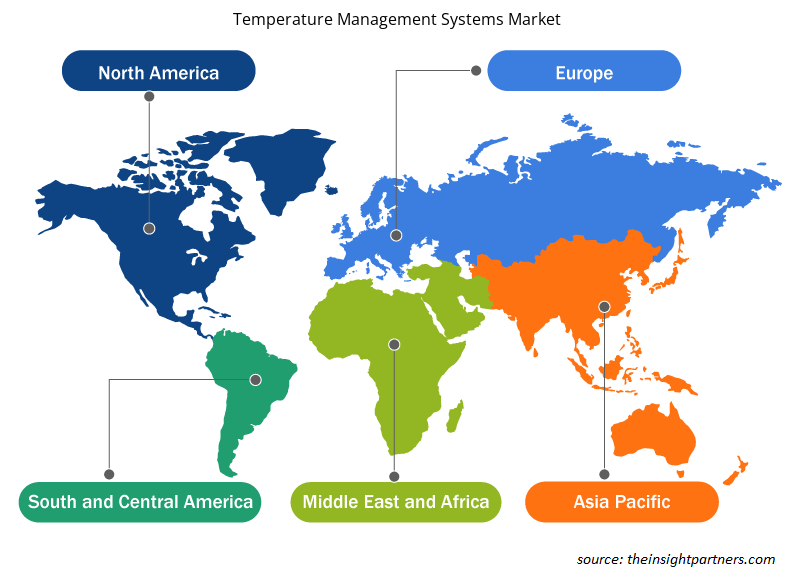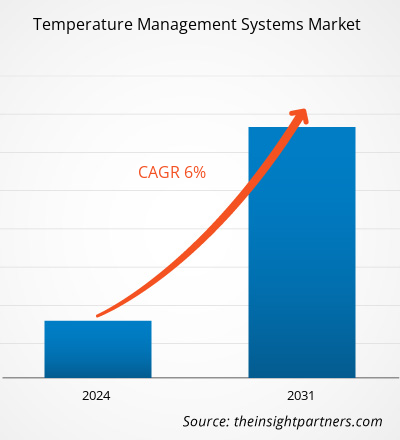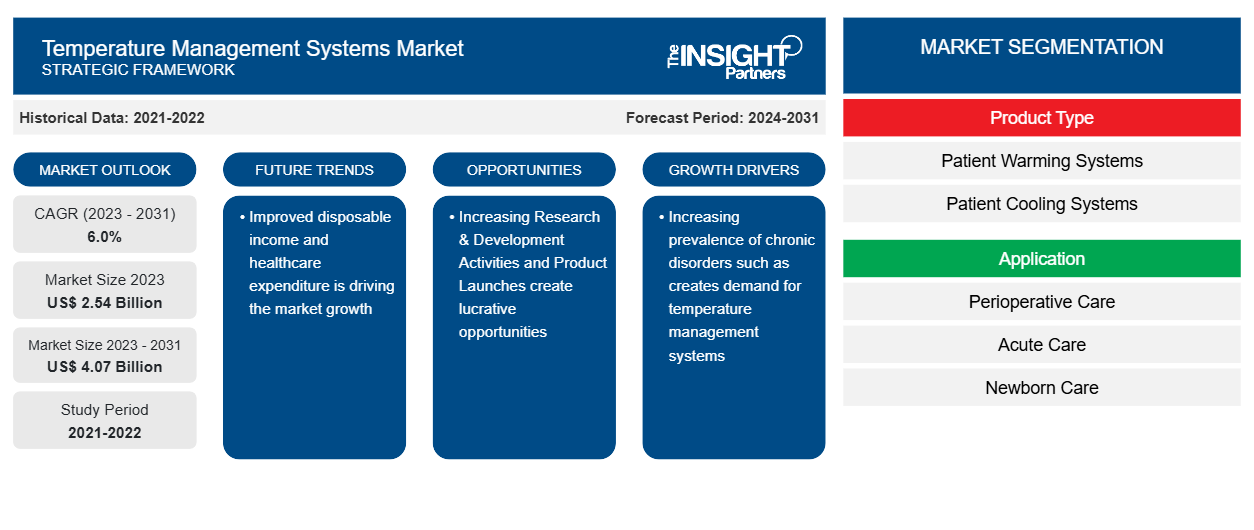Si prevede che il mercato dei sistemi di gestione della temperatura raggiungerà i 4,07 miliardi di dollari entro il 2031, rispetto ai 2,54 miliardi di dollari del 2023. Si prevede che il mercato registrerà un CAGR del 6,0% nel periodo 2023-2031. La crescente inclinazione verso i dispositivi indossabili di monitoraggio della temperatura e i dispositivi terapeutici rimarrà probabilmente una tendenza chiave nel mercato.
Analisi di mercato dei sistemi di gestione della temperatura
Si prevede che la crescente prevalenza di disturbi cronici come ictus, disturbi cardiovascolari, oncologia e altri, insieme all'aumento delle procedure chirurgiche, guideranno la crescita del mercato. Inoltre, l'aumento delle attività di ricerca e sviluppo porta all'innovazione e al lancio di nuovi prodotti sul mercato, seguiti da iniziative strategiche per l'espansione geografica, che probabilmente creeranno ampie opportunità per la crescita del mercato. Tuttavia, la crescente inclinazione verso dispositivi indossabili per il monitoraggio della temperatura e dispositivi terapeutici sono le tendenze chiave del mercato.
Panoramica del mercato dei sistemi di gestione della temperatura
Si prevede che la crescente prevalenza di disturbi cronici come ictus, disturbi cardiovascolari, oncologia e altri, insieme all'aumento delle procedure chirurgiche, guideranno la crescita del mercato. Il Nord America ha dominato la crescita del mercato grazie alle crescenti innovazioni nei sistemi di gestione della temperatura e l'aumento dei disturbi del sistema nervoso centrale sono tra i pochi fattori che si prevede accelereranno la crescita del mercato dei sistemi di gestione della temperatura del Nord America. Inoltre, l'aumento delle attività di R&S e l'introduzione di nuovi prodotti probabilmente aggiungeranno più opportunità al mercato. Tuttavia, si prevede che l'Asia Pacifica registrerà un tasso di crescita significativo dovuto alla crescente tecnologia, alla crescente popolazione geriatrica, alla crescente prevalenza di malattie cardiovascolari. La Cina rappresenta la quota di mercato principale a causa della maggiore prevalenza di malattie ortopediche e cardiache che richiedono cure ospedaliere e alle crescenti attività di ricerca e si prevede che l'India registrerà una crescita significativa durante il periodo di previsione.
Personalizza questo report in base alle tue esigenze
Riceverai la personalizzazione gratuita di qualsiasi report, comprese parti di questo report, o analisi a livello nazionale, pacchetto dati Excel, oltre a usufruire di grandi offerte e sconti per start-up e università
-
Scopri le principali tendenze di mercato in questo rapporto.Questo campione GRATUITO includerà analisi di dati che spaziano dalle tendenze di mercato alle stime e alle previsioni.
Driver di mercato e opportunità dei sistemi di gestione della temperatura
Aumento del numero di interventi chirurgici a favore del mercato
La temperatura corporea è uno dei parametri vitali del corpo umano durante gli interventi chirurgici. Nel caso in cui la temperatura corporea scenda accidentalmente sotto i 36°C (96,8°F), i medici considerano la condizione come ipotermia perioperatoria. Se questa condizione non viene notata abbastanza presto, la bassa temperatura può portare a complicazioni mediche. L'ipotermia perioperatoria si verifica quasi durante tutti gli interventi chirurgici. Un sistema di gestione della temperatura serve come prevenzione dell'ipotermia e semplifica l'anestesia dei pazienti durante gli interventi chirurgici grazie a una fornitura di calore rapida ed efficace.
La crescita della popolazione geriatrica, la crescente prevalenza di malattie croniche, l'aumento del numero di incidenti e l'aumento dei ricoveri ospedalieri hanno portato a un aumento del numero di interventi chirurgici. Grazie ai progressi della tecnologia, vari ospedali e istituti medici eseguono un gran numero di interventi chirurgici all'anno. Ad esempio, in media, 313 milioni di interventi chirurgici vengono eseguiti in tutto il mondo ogni anno.
L'aumento delle attività di ricerca e sviluppo e dei lanci di prodotti crea opportunità redditizie
Gli operatori del settore stanno conducendo un vasto numero di attività di ricerca e sviluppo per sviluppare sistemi avanzati di monitoraggio della temperatura. È probabile che queste partnership tecnologiche offrano significative opportunità per il lancio di nuovi prodotti e l'introduzione di un'ampia varietà di prodotti durante il periodo di previsione. Ad esempio, a gennaio 2024, Microchip Technology ha lanciato la famiglia MCP998x di 10 sensori di temperatura remoti qualificati per l'automotive . Questa nuova famiglia di sensori di temperatura remoti sta ampliando la scelta dei clienti in una categoria di prodotti che, storicamente, ha offerto opzioni limitate. Inoltre, a giugno 2021, ZOLL e Global Healthcare SG hanno firmato un accordo esclusivo per distribuire un sistema portatile di gestione della temperatura mirata nell'area Asia-Pacifico. Inoltre, il consolidamento delle attività di ricerca e sviluppo porta a innovazioni di prodotto che probabilmente offriranno significative opportunità di adozione del prodotto. Allo stesso modo, una solida attenzione alle attività di ricerca può offrire un'ampia opportunità di crescita per il mercato dei sistemi di gestione della temperatura durante il periodo di previsione.
Analisi della segmentazione del rapporto di mercato sui sistemi di gestione della temperatura
I segmenti chiave che hanno contribuito alla derivazione dell'analisi di mercato dei sistemi di gestione della temperatura sono il prodotto, l'applicazione e l'indicazione medica.
- In base al tipo di prodotto, il mercato dei sistemi di gestione della temperatura è diviso in sistemi di riscaldamento dei pazienti e sistemi di raffreddamento dei pazienti. Il segmento dei sistemi di riscaldamento dei pazienti ha detenuto una quota di mercato maggiore nel 2023.
- Per applicazione, il mercato è segmentato in assistenza perioperatoria, assistenza acuta, assistenza neonatale e altri. Il segmento dell'assistenza perioperatoria ha detenuto la quota maggiore del mercato nel 2023.
- In termini di indicazione medica, il mercato è classificato in chirurgia generale, cardiologia, neurologia, pediatria, chirurgia ortopedica, chirurgia toracica, altri. Il segmento della chirurgia generale ha detenuto una quota significativa del mercato nel 2023.
Analisi della quota di mercato dei sistemi di gestione della temperatura per area geografica
L'ambito geografico del rapporto di mercato sui sistemi di gestione della temperatura è suddiviso principalmente in cinque regioni: Nord America, Asia Pacifico, Europa, Medio Oriente e Africa, e Sud e Centro America.
Il Nord America ha dominato il mercato grazie alle crescenti innovazioni nei sistemi di gestione della temperatura e l'aumento dei disturbi del sistema nervoso centrale sono tra i pochi fattori che si prevede accelereranno la crescita del mercato dei sistemi di gestione della temperatura del Nord America. Inoltre, l'aumento delle attività di R&S e l'introduzione di nuovi prodotti probabilmente aggiungeranno più opportunità al mercato. Gli Stati Uniti detengono la quota di mercato maggiore grazie alla crescente prevalenza di malattie croniche e cardiache, al crescente numero di lanci di prodotti da parte di attori chiave e alla crescente attenzione alle misure preventive per affrontare la prevalenza delle malattie e il monitoraggio dei pazienti. Si prevede che l'Asia Pacifica crescerà con il CAGR più elevato nei prossimi anni.
Approfondimenti regionali sul mercato dei sistemi di gestione della temperatura
Le tendenze regionali e i fattori che influenzano il mercato dei sistemi di gestione della temperatura durante il periodo di previsione sono stati ampiamente spiegati dagli analisti di Insight Partners. Questa sezione discute anche i segmenti di mercato dei sistemi di gestione della temperatura e la geografia in Nord America, Europa, Asia Pacifico, Medio Oriente e Africa e Sud e Centro America.

- Ottieni i dati specifici regionali per il mercato dei sistemi di gestione della temperatura
Ambito del rapporto di mercato sui sistemi di gestione della temperatura
| Attributo del report | Dettagli |
|---|---|
| Dimensioni del mercato nel 2023 | 2,54 miliardi di dollari USA |
| Dimensioni del mercato entro il 2031 | 4,07 miliardi di dollari USA |
| CAGR globale (2023-2031) | 6,0% |
| Dati storici | 2021-2022 |
| Periodo di previsione | 2024-2031 |
| Segmenti coperti |
Per tipo di prodotto
|
| Regioni e Paesi coperti |
America del Nord
|
| Leader di mercato e profili aziendali chiave |
|
Densità degli attori del mercato: comprendere il suo impatto sulle dinamiche aziendali
Il mercato dei sistemi di gestione della temperatura sta crescendo rapidamente, spinto dalla crescente domanda degli utenti finali dovuta a fattori quali l'evoluzione delle preferenze dei consumatori, i progressi tecnologici e una maggiore consapevolezza dei vantaggi del prodotto. Con l'aumento della domanda, le aziende stanno ampliando le loro offerte, innovando per soddisfare le esigenze dei consumatori e capitalizzando sulle tendenze emergenti, il che alimenta ulteriormente la crescita del mercato.
La densità degli operatori di mercato si riferisce alla distribuzione di aziende o società che operano in un particolare mercato o settore. Indica quanti concorrenti (operatori di mercato) sono presenti in un dato spazio di mercato in relazione alle sue dimensioni o al valore di mercato totale.
Le principali aziende che operano nel mercato dei sistemi di gestione della temperatura sono:
- 3 milioni
- SOCIETÀ MEDICA ZOLL
- BD
- Farmacia medica Smith
- Società per azioni Dragerwerk AG & Co. KGaA
- Ecolab
Disclaimer : le aziende elencate sopra non sono classificate secondo un ordine particolare.

- Ottieni una panoramica dei principali attori del mercato dei sistemi di gestione della temperatura
Notizie di mercato e sviluppi recenti sui sistemi di gestione della temperatura
Il mercato dei sistemi di gestione della temperatura viene valutato raccogliendo dati qualitativi e quantitativi dopo la ricerca primaria e secondaria, che include importanti pubblicazioni aziendali, dati associativi e database. Di seguito sono elencati alcuni degli sviluppi nel mercato dei sistemi di gestione della temperatura:
- SourceMark ha collaborato con Gentherm Medical per la fornitura di alcune linee di prodotti per il riscaldamento dei pazienti Gentherm negli Stati Uniti, tra cui Astopad, un sistema di riscaldamento resistivo progettato per prevenire e curare l'ipotermia, Norm-O-Temp, un sistema di ipertermia per tutto il corpo, Gelli-Roll, un cuscinetto in gel riscaldante e rinfrescante riutilizzabile, il sistema di riscaldamento convettivo dei pazienti WarmAir e le coperte ad aria calda per il riscaldamento dei pazienti FilteredFlo. (Fonte: SourceMark Medical, comunicato stampa, gennaio 2024)
- Watlow ha lanciato le nuove camicie riscaldanti ad alta temperatura ASSURANT HT progettate per soddisfare le esigenze uniche della lavorazione dei semiconduttori. Queste soluzioni offrono un riscaldamento uniforme per profili di temperatura uniformi sull'intera linea riscaldata. Le camicie riscaldanti ASSURANT ottimizzano i tempi di attività degli utensili di processo e la resa dei trucioli fornendo una copertura completa alla linea eliminando i punti freddi che causano l'accumulo di particelle. (Fonte: Watlow Electric Manufacturing Company, sito Web aziendale, ottobre 2023)
- ZOLL ha collaborato con BrainCool per la distribuzione esclusiva del sistema BrainCool/sistema IQool e dei cuscinetti del sistema IQool negli Stati Uniti e nei mercati chiave in Europa e sta lavorando per espandere la distribuzione in mercati selezionati in Asia. (Fonte: ZOLL Medical Corporation, sito Web aziendale, luglio 2023)
Copertura e risultati del rapporto di mercato sui sistemi di gestione della temperatura
Il rapporto "Dimensioni e previsioni del mercato dei sistemi di gestione della temperatura (2021-2031)" fornisce un'analisi dettagliata del mercato che copre le seguenti aree:
- Dimensioni e previsioni del mercato dei sistemi di gestione della temperatura a livello globale, regionale e nazionale per tutti i principali segmenti di mercato coperti dall'ambito
- Tendenze del mercato dei sistemi di gestione della temperatura e dinamiche di mercato come driver, restrizioni e opportunità chiave
- Analisi dettagliata delle cinque forze PEST/Porter e SWOT
- Analisi di mercato dei sistemi di gestione della temperatura che copre le principali tendenze di mercato, il quadro globale e regionale, i principali attori, le normative e i recenti sviluppi del mercato
- Analisi del panorama industriale e della concorrenza che copre la concentrazione del mercato, l'analisi della mappa termica, i principali attori e gli sviluppi recenti per il mercato dei sistemi di gestione della temperatura
- Profili aziendali dettagliati
- Analisi storica (2 anni), anno base, previsione (7 anni) con CAGR
- Analisi PEST e SWOT
- Valore/volume delle dimensioni del mercato - Globale, Regionale, Nazionale
- Industria e panorama competitivo
- Set di dati Excel
Report recenti
Rapporti correlati
Testimonianze
Motivo dell'acquisto
- Processo decisionale informato
- Comprensione delle dinamiche di mercato
- Analisi competitiva
- Analisi dei clienti
- Previsioni di mercato
- Mitigazione del rischio
- Pianificazione strategica
- Giustificazione degli investimenti
- Identificazione dei mercati emergenti
- Miglioramento delle strategie di marketing
- Aumento dell'efficienza operativa
- Allineamento alle tendenze normative























 Ottieni un campione gratuito per - Mercato dei sistemi di gestione della temperatura
Ottieni un campione gratuito per - Mercato dei sistemi di gestione della temperatura